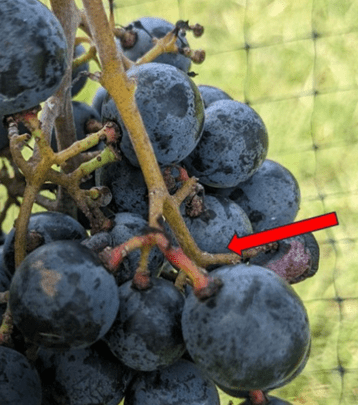Pierce’s Disease—Background and Management
Pierce’s Disease (PD) of grapevines is caused by a bacterium, Xylella fastidiosa subsp. Fastidiosa. It was first described in California in the 1800s, is commonly found in vineyards bordering the Gulf Coast, and more recently the Mid-Atlantic, including Virginia and North Carolina, and the southern Midwest. It is typically found in hot climate regions but has been slowly moving into more northern regions. In the South it can infect and quickly kill entire vineyards but as it moves north to areas experiencing cold winters, it tends to spotty and sometimes transient appearance in vineyards.
The Pierce’s Disease Pathogen and Vector
- Xylella fastidiosa is a gram-negative bacterium that survives and multiplies in the water-conducting elements (xylem) of grapevines and produces a biofilm that eventually blocks the xylem from transporting water and nutrients through the plant.
- The bacterium has a broad host range with more than 100 known plant hosts, but strains show specialization for certain hosts.
- Only specific strains of the bacterium are capable of infecting grapevines.
- The bacterium that causes PD is native to North America where there are native grape species.
- The bacterium is typically transmitted from plant to plant by an insect vector, including spittle bugs and leafhoppers.
- There is also a low risk of mechanical transmission of the pathogen.
- The risk of spreading the bacterium through pruning practices is also considered low during the winter months.
- The risk is much higher when pruning practices occur during periods of active vine growth, so in high risk vineyards, it is recommended that pruning equipment be sanitized after working on each vine.
- The bacterium can also be transmitted through use of propagation material taken from infected grape vines.
Pierce’s Disease Symptoms
- As the pathogen multiplies in and block the xylem, symptoms are expressed as severe water stress or drought including wilting and premature defoliation.
- Symptoms tend to appear later in the summer when it is hot and dry but can appear earlier under dry conditions and drought stress.
- Leaf symptoms include interveinal and edge leaf scorch with a yellow border/transition between the brown and green tissue. The yellow border is the defining symptom to separate from simple drought stress (Figure 1).
- A ‘matchsticks’ symptom is created where the leaves have dropped but petioles remain attached to the shoot (Figure 2).
- The peduncle of the berry on the rachis might also show a red coloration on certain cultivars (Figure 3).
- Maturing fruit clusters may color and shrivel prematurely; this may occur in newly infected vines even before foliar symptoms are observed (Figure 4).
- Depending on duration and level of infection, productivity can range from reduced yield with poor fruit quality to no production at all.




